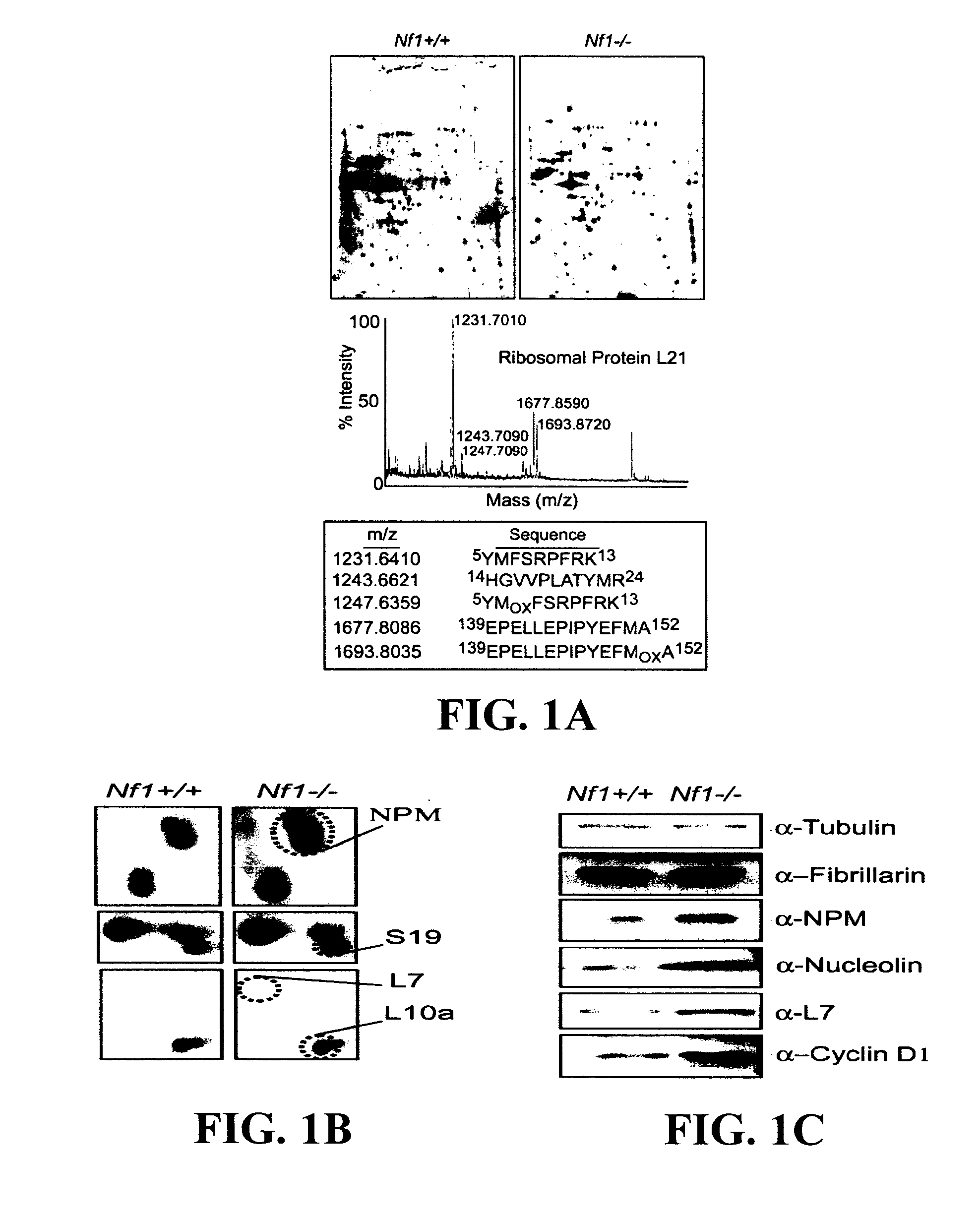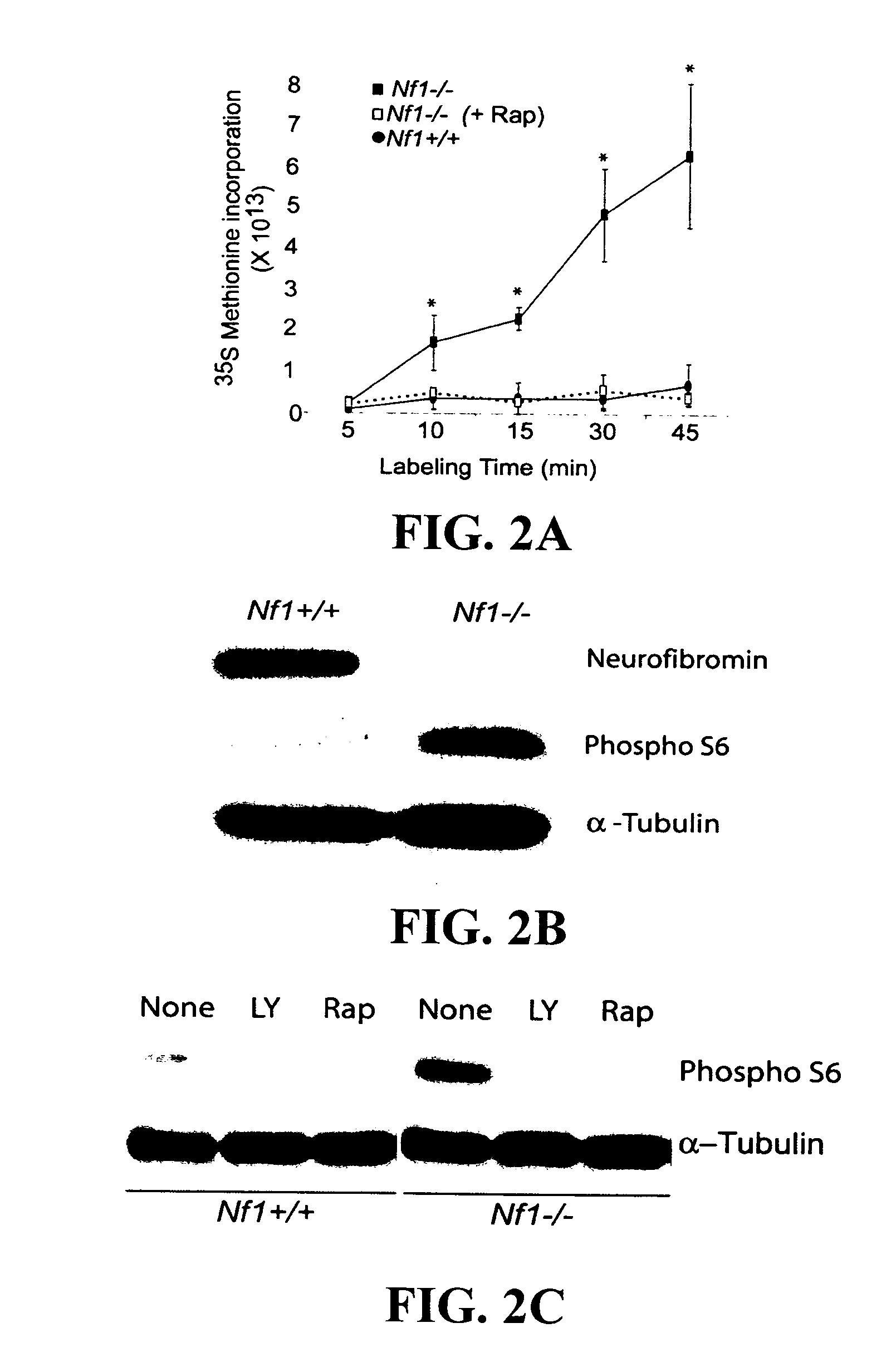Methods for treating neurofibromatosis 1
a neurofibromatosis and neurofibromatosis technology, applied in the field of neurofibromatosis 1 treatment methods, can solve the problems of early puberty, loss of vision, and frequent fatalities
- Summary
- Abstract
- Description
- Claims
- Application Information
AI Technical Summary
Benefits of technology
Problems solved by technology
Method used
Image
Examples
example 1
Materials and Methods
[0077] This example describes the materials and methods used in Examples 2-7 below.
A. Mice
[0078] GFAP-Cre-IRES-LacZ transgenic (GFAPCre) mice were generated as described in Bajenaru M L et al., Astrocyte-Specific Inactivation of the Neurofibromatosis 1 Gene (NF1) is Insufficient for Astrocytoma Formation, MOL. CELL. BIOL. 22:5100-5113 (2002). Lox-stop-lox (LSL)-K-RASG12D mice were provided by Dr. Tyler Jacks from the Massachusetts Institute of Technology, Boston, Mass., and can be generated as described in Jackson E L, et al., Analysis of Lung Tumor Initiation and Progression Using Conditional Expression of Oncogenic K-ras, GENES DEV. 15:3243-3248 (2001). Lox-stop-lox (LSL)-K-RASG12D mice were crossed with GFAPCre mice to obtain (LSL)-K-RASG12D; GFAPCre mice. Nf1flox / flox mice were provided by Dr. Luis Parada from the University of Texas Southwestern Medical Center, Dallas, Tex., and are available from the Mouse Models for Human Cancers Consortium E-Mice Repo...
example 2
Proteomic Analysis Uncovers Hyperactivation of the mRNA Translation Machinery in Nf1-Deficient Astrocytes
[0085] A large-scale proteomic analysis of primary astrocytes lacking neurofibromin was performed to determine whether loss of neurofibromin expression results in the activation of unique downstream signaling cascades. Proteins extracted from asynchronous wild-type (Nf1+ / +) and Nf1− / − astrocytes were separated by two-dimensional electrophoresis using protein isoelectric points in the first dimension and protein molecular weights in the second dimension. When compared using PDQuest software, over 100 visualized proteins exhibited significant expression deviation (>1.5-fold) between Nf1+ / + and Nf1− / − extracts (FIG. 1A). Differentially expressed proteins were excised and analyzed by MALDI-TOF for initial identification. For example, ribosomal protein L21 was positively identified by peptide matching (FIG. 1A), and exhibited a 1.5-fold increase in protein expression in Nf1− / − astroc...
example 3
Neurofibromin Loss Results in Increased Protein Synthesis in Astrocytes
[0087] Translational regulation and control of ribosome biogenesis are vital cellular processes that directly impact on cell proliferation and growth. Activated RAS and AKT control protein translation, and the combination of activated RAS and AKT has been shown to recruit specific growth-promoting mRNAs to polysomes in glial cells. See Rajasekhar V K, et al., Oncogenic Ras and Akt Signaling Contribute to Glioblastoma Formation by Differential Recruitment of Existing mRNAs to Polysomes, MOL. CELL 12:889-901 (2003). Since several proteins associated with protein translation were aberrantly expressed in Nf1− / − astrocytes (see Example 2), an investigation was performed to determine whether the changes in protein expression were associated with an increase in the overall rate of protein synthesis. Nf1+ / + and Nf1− / − astrocytes were pulsed with 35S-methionine, and the amount of radioactivity incorporated into newly syn...
PUM
| Property | Measurement | Unit |
|---|---|---|
| attention deficit disorder | aaaaa | aaaaa |
| blood pressure | aaaaa | aaaaa |
| time | aaaaa | aaaaa |
Abstract
Description
Claims
Application Information
 Login to View More
Login to View More - R&D
- Intellectual Property
- Life Sciences
- Materials
- Tech Scout
- Unparalleled Data Quality
- Higher Quality Content
- 60% Fewer Hallucinations
Browse by: Latest US Patents, China's latest patents, Technical Efficacy Thesaurus, Application Domain, Technology Topic, Popular Technical Reports.
© 2025 PatSnap. All rights reserved.Legal|Privacy policy|Modern Slavery Act Transparency Statement|Sitemap|About US| Contact US: help@patsnap.com



